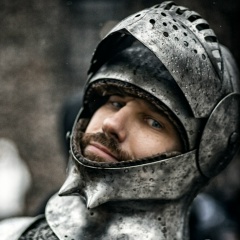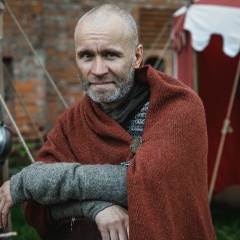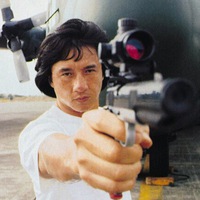Про двуручные мечи в 15 веке
Полагаю необходимым высказаться, так как тема действительно интересна. Уверен, что не только для "узкого круга".
В ходе обсуждения с Вадимом Сеничевым (https://vk.com/heldar1) пришли к интересным мыслям:
судя по всему, наиболее ранний трактат, описывающий двуручные мечи и технику боя с ними- трактат Филиппа де Вади https://wiktenauer.com/wiki/Philippo_di_Vadi). Написан в наиболее «продвинутом» регионе Европы на то время- в Северной Италии в качестве подарка Урбинскому герцогу Гвидобальдо де Монтефельтро.
Форма и габариты мечей описаны относительно подробно:
La spada vole avere iusta misura
vole arivare el pomo sotto el brazio
come qui apare nella mia scriptura
The sword should be of the just measure,
The pommel should come under the arm
As it appears here in my writing.
т. е. меч такой высоты, чтобы яблоко было в районе подмышки. Это не классические двуручные мечи пехотинцев 16-го века, но уже и не совсем «длинный меч» 15-го.
Интересно, что для боя в доспехах автор предлагает заточить крестовину и яблоко, оставляя клинок незаточенным- очень разумно, на мой вкус.
Процитирую Вадима: "...есть артефакты, которые не ранее 2 половины века можно принять за меч, который точно не "полуторный" и не лангшверт, но они вообще единичные и очень конкретные.
с 1490 - да, есть большое количество примеров больших мечей, после 1500 - вообще как отдельный класс оружия со своими конструктивными признаками."
Лучше и не скажешь.
Замечу также, что без оговорок термин "двуручный меч" распространяется только на те мечи, которые "отдельный класс оружия". И это совсем не то, чем сражались на турнирах- как наглядно видно из приведенных изображений:
картинка 1: изображение меча из трактата Вади (не Сеничева, Фелиппо де Вади ;) ). Вещь экзотичная, но интересная. В 16 веке фехтования такими мечами в трактатах становится больше.
картинка два: "Всадник" Альбрехта Дюрера, Музей графического искусства Альбертина, Вена (Graphische Sammlung Albertina, Wien)
на боку- "длинный меч" 15 века.
картинка три: "Галлогласы", Альбрехта Дюрера.
Взяты гравюры одного автора- обратите внимание на разницу этих мечей. Длинный меч- оружие всадника, которое может применяться с седла, или пешком. Двуручный меч- оружие, непригодное для действий верхом.
P.S. картинка четыре: автор текста с двумя мечами: длинный меч средневековья (своеобразный, но пропорции "те"), двуручный меч 16 века. Я думаю, разница очевидна.
Полагаю необходимым высказаться, так как тема действительно интересна. Уверен, что не только для "узкого круга".
В ходе обсуждения с Вадимом Сеничевым (https://vk.com/heldar1) пришли к интересным мыслям:
судя по всему, наиболее ранний трактат, описывающий двуручные мечи и технику боя с ними- трактат Филиппа де Вади https://wiktenauer.com/wiki/Philippo_di_Vadi). Написан в наиболее «продвинутом» регионе Европы на то время- в Северной Италии в качестве подарка Урбинскому герцогу Гвидобальдо де Монтефельтро.
Форма и габариты мечей описаны относительно подробно:
La spada vole avere iusta misura
vole arivare el pomo sotto el brazio
come qui apare nella mia scriptura
The sword should be of the just measure,
The pommel should come under the arm
As it appears here in my writing.
т. е. меч такой высоты, чтобы яблоко было в районе подмышки. Это не классические двуручные мечи пехотинцев 16-го века, но уже и не совсем «длинный меч» 15-го.
Интересно, что для боя в доспехах автор предлагает заточить крестовину и яблоко, оставляя клинок незаточенным- очень разумно, на мой вкус.
Процитирую Вадима: "...есть артефакты, которые не ранее 2 половины века можно принять за меч, который точно не "полуторный" и не лангшверт, но они вообще единичные и очень конкретные.
с 1490 - да, есть большое количество примеров больших мечей, после 1500 - вообще как отдельный класс оружия со своими конструктивными признаками."
Лучше и не скажешь.
Замечу также, что без оговорок термин "двуручный меч" распространяется только на те мечи, которые "отдельный класс оружия". И это совсем не то, чем сражались на турнирах- как наглядно видно из приведенных изображений:
картинка 1: изображение меча из трактата Вади (не Сеничева, Фелиппо де Вади ;) ). Вещь экзотичная, но интересная. В 16 веке фехтования такими мечами в трактатах становится больше.
картинка два: "Всадник" Альбрехта Дюрера, Музей графического искусства Альбертина, Вена (Graphische Sammlung Albertina, Wien)
на боку- "длинный меч" 15 века.
картинка три: "Галлогласы", Альбрехта Дюрера.
Взяты гравюры одного автора- обратите внимание на разницу этих мечей. Длинный меч- оружие всадника, которое может применяться с седла, или пешком. Двуручный меч- оружие, непригодное для действий верхом.
P.S. картинка четыре: автор текста с двумя мечами: длинный меч средневековья (своеобразный, но пропорции "те"), двуручный меч 16 века. Я думаю, разница очевидна.
About two-handed swords in the 15th century
I think it is necessary to speak, because the topic is really interesting. I am sure that not only for the "narrow circle".
During the discussion with Vadim Senichev (https://vk.com/heldar1), we came up with some interesting thoughts:
apparently, the earliest treatise describing two-handed swords and the technique of fighting with them is the treatise of Philippe de Wadi https://wiktenauer.com/wiki/Philippo_di_Vadi). It was written in the most "advanced" region of Europe at that time - in Northern Italy as a gift to the Duke of Urbino Guidobaldo de Montefeltro.
The shape and dimensions of the swords are described in relative detail:
La spada vole avere iusta misura
vole arivare el pomo sotto el brazio
come qui apare nella mia scriptura
The sword should be of the just measure,
The pommel should come under the arm
As it appears here in my writing.
that is, the sword is so high that the apple is in the armpit. These are not the classic two-handed swords of the infantrymen of the 16th century, but not quite the "longsword" of the 15th.
Interestingly, for fighting in armor, the author proposes to sharpen the crosspiece and the apple, leaving the blade unsharpened - very reasonable, for my taste.
I will quote Vadim: "... there are artifacts that, not earlier than the second half of the century, can be mistaken for a sword, which is definitely not a" one and a half "and not a langshwert, but they are generally single and very specific.
since 1490 - yes, there are a large number of examples of large swords, after 1500 - generally as a separate class of weapons with their own design features. "
It couldn't be better.
I also note that without reservation, the term "two-handed sword" applies only to those swords that are "a separate class of weapons." And this is not at all what we fought in tournaments, as can be clearly seen from the above images:
picture 1: image of a sword from the treatise of Wadi (not Senichev, Felippo de Wadi;)). The thing is exotic, but interesting. In the 16th century, fencing with such swords in treatises becomes more common.
picture two: "The Horseman" by Albrecht Durer, Albertina Museum of Graphic Art, Vienna (Graphische Sammlung Albertina, Wien)
on the side there is a "long sword" of the 15th century.
picture three: "Galloglas" by Albrecht Durer.
Engravings taken from one author - note the difference between these swords. The long sword is a rider's weapon that can be used from the saddle or on foot. The two-handed sword is a weapon not suitable for riding.
P.S. picture four: the author of the text with two swords: a long sword of the Middle Ages (peculiar, but proportions "te"), a two-handed sword of the 16th century. I think the difference is obvious.
I think it is necessary to speak, because the topic is really interesting. I am sure that not only for the "narrow circle".
During the discussion with Vadim Senichev (https://vk.com/heldar1), we came up with some interesting thoughts:
apparently, the earliest treatise describing two-handed swords and the technique of fighting with them is the treatise of Philippe de Wadi https://wiktenauer.com/wiki/Philippo_di_Vadi). It was written in the most "advanced" region of Europe at that time - in Northern Italy as a gift to the Duke of Urbino Guidobaldo de Montefeltro.
The shape and dimensions of the swords are described in relative detail:
La spada vole avere iusta misura
vole arivare el pomo sotto el brazio
come qui apare nella mia scriptura
The sword should be of the just measure,
The pommel should come under the arm
As it appears here in my writing.
that is, the sword is so high that the apple is in the armpit. These are not the classic two-handed swords of the infantrymen of the 16th century, but not quite the "longsword" of the 15th.
Interestingly, for fighting in armor, the author proposes to sharpen the crosspiece and the apple, leaving the blade unsharpened - very reasonable, for my taste.
I will quote Vadim: "... there are artifacts that, not earlier than the second half of the century, can be mistaken for a sword, which is definitely not a" one and a half "and not a langshwert, but they are generally single and very specific.
since 1490 - yes, there are a large number of examples of large swords, after 1500 - generally as a separate class of weapons with their own design features. "
It couldn't be better.
I also note that without reservation, the term "two-handed sword" applies only to those swords that are "a separate class of weapons." And this is not at all what we fought in tournaments, as can be clearly seen from the above images:
picture 1: image of a sword from the treatise of Wadi (not Senichev, Felippo de Wadi;)). The thing is exotic, but interesting. In the 16th century, fencing with such swords in treatises becomes more common.
picture two: "The Horseman" by Albrecht Durer, Albertina Museum of Graphic Art, Vienna (Graphische Sammlung Albertina, Wien)
on the side there is a "long sword" of the 15th century.
picture three: "Galloglas" by Albrecht Durer.
Engravings taken from one author - note the difference between these swords. The long sword is a rider's weapon that can be used from the saddle or on foot. The two-handed sword is a weapon not suitable for riding.
P.S. picture four: the author of the text with two swords: a long sword of the Middle Ages (peculiar, but proportions "te"), a two-handed sword of the 16th century. I think the difference is obvious.




У записи 94 лайков,
19 репостов,
5623 просмотров.
19 репостов,
5623 просмотров.
Эту запись оставил(а) на своей стене Андрей Богданов







































































